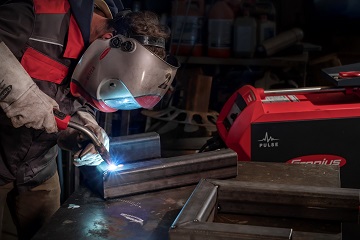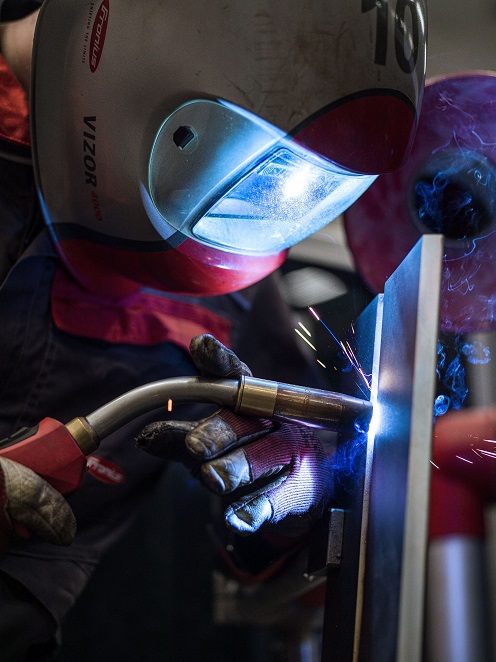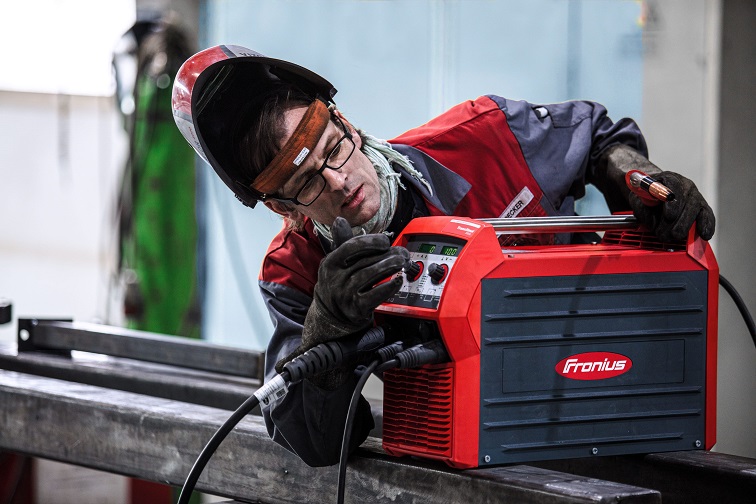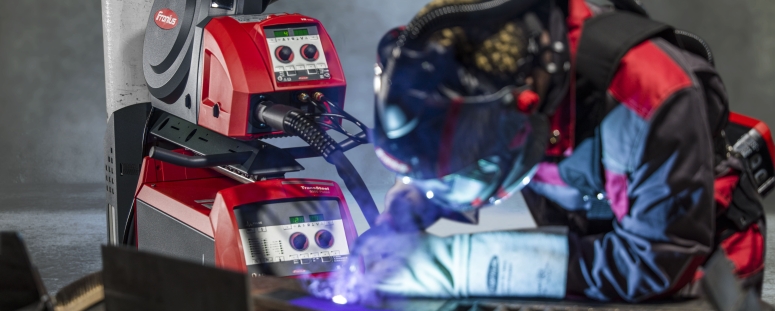Choosing the right MIG/MAG welding machine can be a challenge, especially with the multitude of manufacturers and models available on the market. To help you make an informed decision, here are some considerations for selecting the MIG/MAG welding machine that will meet your specific needs.
1- Determine your welding needs
The first step in selecting a MIG/MAG welder is to determine your welding needs. Here are some points to consider when evaluating your specific needs:
a. Materials
Identify the types of materials you will be welding, such as steel, stainless steel, aluminum or other metals. Different materials may require specific welding configurations, types of welding wire or shielding gases.
Copyright Fronius b. Material grades and thickness
The thickness of the materials you plan to weld will have an impact on the power output requiredby your welding machine. Thicker materials generally require a higher power output to ensure adequate penetration and a strong weld.
c. Frequency and duration of welding operations
Consider how often you plan to weld and how long each welding session will last. If you plan to weld frequently or for long periods of time, it is important to choose a welding machine with a high duty cycle to avoid overheating problems.
d. Level of accuracy and finish
The level of accuracy and finish required for your welding jobs will depend on the type of applications you are using the welder for. Projects requiring a high aesthetic finish or high precision welds may require advanced features (or particular electrical currents - transfer modes), such as pulsed welding or pre-set programs for different materials and thicknesses.
Assessing these issues will help you determine your specific welding needs and select a suitable MIG/MAG welding machine. This assessment will also help you to better understand other aspects to consider when choosing a welding machine, such as power output, duty cycle and required accessories.
2- Understanding the differences between MIG and MAG technologies
Although many modern welding machines combine MIG and MAG technologies in one device, it is important to understand the differences between these two welding methods to choose the right welding machine for your specific needs:

Copyright Fronius a. MIG (Metal Inert Gas)
MIG welding uses an inert gas, usually argon or a mixture of argon and other gases, to protect the welding area from oxidation and contamination. MIG welding is often used to weld aluminium, stainless steel and other non-ferrous materials. It is also suitable for welds where aesthetic appearance is important, as it produces a clean, uniform weld seam.
b. MAG (Metal Active Gas)
MAG welding uses an active gas, usually carbon dioxide or a mixture of carbon dioxide and argon, to shield the weld area. MAG welding is commonly used to weld ferrous materials, such as carbon steel. This method is generally faster and more economical than MIG welding, but can produce a less aesthetically pleasing weld seam.
By understanding the differences between MIG and MAG technologies, you will be able to choose a welding machine that suits your needs in terms of materials, applications and desired finish. For most users, a welding machine combining both MIG/MAG technologies will offer the greatest versatility (often through the choice of welding synergy) and will be the most suitable choice.
3- Consider power and duty cycle
Power output and duty cycle are important elements to consider when choosing a MIG/MAG welding machine. Here are explanations for each of these terms and how they affect your choice:
a. Power output
The power output of a welding machine, usually expressed in amperes (A), determines the thickness of the materials you can weld. The higher the power output, the thicker the material you can weld. To choose the right welding machine for your needs, it is important to consider the materials and thicknesses you plan to weld most often and to choose a welding machine with an appropriate power output.
b. Duty cycle
The duty cycle, expressed as a percentage (%), indicates how long the welding machine can operate at a given power output without overheating. For example, a duty cycle of 60% at 200A means that the welder can run for 6 minutes at 200A before having to cool down for 4 minutes. A high duty cycle is important for intensive or long duration welding jobs as it minimises downtime due to overheating of the equipment.
c- The impact of ecodesign regulations for MIG/MAG welding machines
A new element to be taken into account when assessing MIG/MAG welding machines is the Ecodesign regulation, Commission Regulation (EU) 2019/1784 of 1 October 2019, applicable from 1 January 2023. This regulation aims to reduce the environmental impact of electrical equipment, including welding machines. From now on, it will be possible to compare soldering machines on the basis of their standby power consumption (less than 50 watts) and their energy efficiency. This comparison allows users to choose more environmentally friendly soldering stations, while reducing energy costs in the long term.
When choosing a MIG/MAG welding machine for your needs, it is essential to consider the power output and duty cycle. Make sure you choose a welding machine with sufficient power output to weld the materials and thicknesses you normally work with, and a duty cycle that is appropriate for the frequency and duration of your welding operations.
4- Choose a model with simple and accurate settings
It is essential to choose a MIG/MAG welding machine that offers simple and accurate settings to facilitate the welding process and ensure high quality results. Here are some key things to look for in terms of settings:

Copyright Fronius a. Voltage setting
A quality MIG/MAG welding machine should allow easy and accurate adjustment of the arc voltage. The arc voltage influences the width and penetration of the weld bead. Proper tension setting ensures a clean and uniform weld.
b. Adjusting the gas flow
The flow of shielding gas, usually argon, CO2, or a mixture of both, is essential to ensure the quality of the MIG/MAG weld. A welding machine must allow precise and stable adjustment of the gas flow throughout the welding process. Several factors can influence this flow rate, such as the size and type of nozzle, the distance between the nozzle and the workpiece, the welding speed and the environmental conditions (e.g. wind). Incorrectly adjusted gas flow can lead to various problems, such as porosity (formation of small cavities in the weld) and oxidised welds, which affect the strength and appearance of the weld.
c. Adjusting the wire speed
The speed of the welding wire directly affects the penetration and appearance of the weld. A MIG/MAG welding machine must allow for precise control of wire speed to ensure a consistent and well-formed weld.
d. Synergies and pre-set programmes
Some MIG/MAG welding machines offer synergies or pre-set programs for different materials, thicknesses and wire types. These programs make set-up easier by automatically adjusting the tension, wire speed and gas flow to the selected parameters. These features are particularly useful for beginners or to save time when changing materials or thicknesses.
e. Digital display and user interface
A MIG/MAG welding machine with a digital display and a user-friendly interface makes it easy to read and adjust the welding parameters. It is important to choose a model with a clear and intuitive interface to simplify the setting process and ensure optimum results.
By choosing a MIG/MAG welder with simple and accurate settings, you will have better control over the welding process, which will result in better quality welds and greater job satisfaction.
5- Check the consumables, accessories, and options available
Accessories and options can improve the performance and versatility of your MIG/MAG welding machine. Here are some of the commonly available accessories and options:
a. Welding torches
Welding torches are used to guide the welding wire to the welding area (seam). They are available in different sizes, lengths, duty cycles and types, including air-cooled and water-cooled torches. Water-cooled torches are recommended for high-intensity work, as they offer better cooling and longer life. There is a wide variety of torches available at different quality and price levels.
b. Gas cylinders
Gas cylinders contain the shielding gas needed for MIG/MAG welding. Make sure that the welding machine is compatible with the gas cylinders you plan to use and that it has a pressure regulator to control the gas flow.
c. Welding wire
Welding wire (packed in reels of several kg) is available in different material grades, qualities and diameters to suit different applications. Make sure that the welding machine is compatible with the welding wires you plan to use.
d. Wire feeders
The quality of the wire feeder is a key factor in the quality of the weld and has a significant impact on the quality of the weld bead. A wire feeder is a device that feeds the welding wire into the torch. Some MIG/MAG welding machines are equipped with built-in wire feeders (called compact), while others require external wire feeders (called separate). Make sure you choose a welding machine with a suitable wire feeder for your needs, e.g. with a 2-roller or 4-roller wire feed motor. 4 rollers are recommended for welding aluminium. The shape of the roller groove also has an impact on the quality of the wire feed.
e. Water cooling
Water cooling systems help to keep the temperature of the torch and welding unit under control during heavy duty work. This option is generally recommended for industrial applications or for high-intensity welding.
f. Remote welding adjustment and setting
Remote welding allows the welder to be controlled by a remote control or foot pedal, providing greater flexibility and accuracy when welding. This option is particularly useful for positional welding or for jobs where precise control of wire speed and tension is required. There are remote controls built directly into the torch, or wireless remote controls to avoid cutting the excess trailing wire.
g. Pulsed welding
Pulsed welding is an advanced feature that alternates between high and low current, allowing for better control of bath and drip release, penetration and weld bead formation, with less spatter and fumes. This option is particularly useful for welding on thin or heat sensitive materials.
6- Connected MIG/MAG welding machines for better welding optimisation and traceability
The digitalisation of MIG/MAG welding machines brings many advantages in terms of ease of use, precision, efficiency and traceability. Here are some key points to consider when evaluating digital welding machines:
a. User interface and display
Digital welders have a user-friendly interface and a clear display that makes it easy to read and adjust welding parameters. An intuitive user interface simplifies the setting process and allows quick access to the functions and parameters of the welding unit.
b. Advanced features
Digital welders can include advanced features, such as pulsed welding, for better welding results, or other current transfer modes, sometimes very brand specific. These functions can, for example, save time when changing materials or thicknesses, among other benefits.
c. Connectivity and software updates
Digital welding machines can offer connectivity options, such as RJ45, Wi-Fi or Bluetooth, to connect to other equipment or to perform software updates. Connectivity and software updates ensure that your soldering station stays up to date with the latest technologies and improvements.
d. Traceability
The digitisation of welding machines allows for increased traceability of welding operations. Digital welders can record data such as welding parameters, welding times and gas consumption, allowing monitoring and analysis of welding performance and improving work quality. Traceability is particularly useful in industries where quality and compliance are essential, such as aerospace, automotive or shipbuilding.
By choosing a digital MIG/MAG welder, you will benefit from greater ease of use, precise control of welding parameters, advanced features and improved traceability. The digitisation of welding machines represents a major advance in the field of welding and offers many advantages to users.
Conclusion: In summary, to choose the ideal MIG/MAG welder, it is crucial to determine your welding needs, understand the differences between MIG and MAG welding, and consider aspects such as power, duty cycle, settings and available accessories, not to mention the benefits of welder digitisation.
Metal-Interface takes great care to protect your privacy: when you submit a request or ask a question, your personal information is passed on to the supplier concerned or, if necessary, to one of its regional managers or distributors, who will be able to provide you with a direct response. Consult our Privacy Policy to find out more about how and why we process your data, and your rights in relation to this information. By continuing to browse our site, you accept our terms and conditions of use.
 Welding technologies Technical article
Welding technologies Technical articleHow to choose the ideal MIG/MAG welding machine? Performance, ease of use, traceability, primary consumption, etc.
